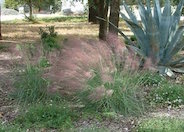
Common name:Rosemary Tuscan Blue
Botanical name:Rosmarinus officinalis 'Tuscan Blue'
Rosemary officinalis 'Tuscan Blue' is an upright shrub that grows 3'-6' tall. It has aromatic dark green leaves and bright showy lavender-blue flowers throughout the year. This shrub is drought tolerant and attracts butterflies.

Common name:Bi-colored Hesperaloe
Botanical name:Hesperaloe parviflora 'Duet'
Spectacular accent for desert gardens anywhere. Plants tolerate drought, full sun, reflected heat, and poor soils. Forms rosettes of leaves 4' x 6'. The red and yellow flower stalks emerge in spring and remain on the plant until the end of summer. - Mountain States Nursery

Common name:Pink Muhly
Botanical name:Muhlenbergia capillaris
Mounding grass grows quickly to 3' x 3'. Leaves are medium green and turn tan in fall. Pink airy plumes appear in fall. Place plants where pink flower plumes can be backlit by the sun. Look for selections with deep pink flower plumes. Accepts full sun or partial shade. Very frost tolerant. Prune in early spring for best looking new growth. Native to Texas and Mexico.

Common name:Arizona Cottontop
Botanical name:Digitaria californica
Arizona Cottontop is a beautiful grass with long whitish hairs that give it a "cottony" appearance. Numerous leaves surround the 3' tall and 1.5' wide culms which bear attractive white flowers in the summer to early fall. Irrigate every 2-3 weeks, after the grass is established, especially during summer. This grass is strongly allergenic for some people.

Common name:Big Blue Stem
Botanical name:Andropogon gererdii
Big Blue Stem is a medium sized ornamental grass that can grow to 6 feet in height. It is hardy and is best left to naturalize.
| Designer: Sallie Homan | Red Tile Garden 1 |
Photographer: GardenSoft |
Soils and Compost:
Maintain a two to four inch layer of mulch on the soil surface to reduce weeds, infiltrate rain water, and reduce compaction.
Water Saving Tip:
Different areas of your landscape have different water requirements.
Shrubs need much less water than lawns and drip systems should never be scheduled on the same program with lawns.
Establish separate watering schedules for those areas.
Integrated Pest Management:
Drip and other smart irrigation delivers water directly to roots, allowing no excess water for weeds.
